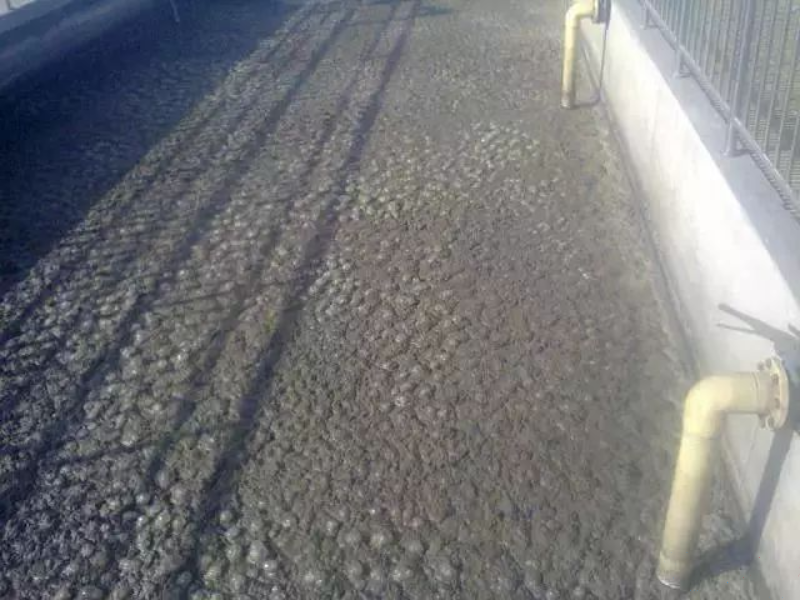Consultation hotline:
(+86)0532-88988868
(+86)0532-88988868
There are many reasons for sludge blackening during sewage treatment operation, such as the lack of dissolved oxygen in the aeration tank causing sludge blackening, and the presence of a large amount of pigment substances in the influent.
The blackening of sludge in aeration tanks is often caused by a lack of dissolved oxygen. Therefore, once sludge blackening occurs, the first step is to check the dissolved oxygen content in the aeration tank, and then check the inlet water quality. Based on the results of the water quality inspection, the specific cause should be determined. The common causes and countermeasures of sludge blackening are as follows:
Blackening of sludge caused by low DO
The corresponding solution is to increase the oxygen supply of the aeration tank, so that the mass concentration of dissolved oxygen is greater than 2mg/L and can reach 4-5mg/L in a short period of time. As long as the dissolved oxygen content of the mixed solution in the aeration tank is increased, the sludge will gradually return to normal in a few hours.
Blackening of aeration tank sludge caused by incoming water quality
For example, when the incoming water contains a large amount of Fe2+, and the dissolved oxygen in the aeration tank is insufficient, the anaerobic decomposition of organic matter will release H2S. H2S reacts with Fe2+to generate FeS, which is black brown in color and will cause the entire aeration tank sludge to turn black.

The corresponding solution is to determine the cause of sludge blackening through water quality testing, and then prescribe the right medicine accordingly; Meanwhile, the blackening of sludge in the aeration tank can be improved by increasing the aeration rate and reflux ratio.
When the incoming water contains substances that are toxic to microorganisms, it can cause microbial death and blackening of the sludge in the aeration tank
The corresponding solution is to first check the quality of the incoming water. If the incoming water contains toxic substances that are highly toxic to microorganisms, it must be controlled from the front end. Secondly, increasing the aeration rate and reflux can improve the load resistance of the aeration tank, thereby improving the blackening of the sludge. In the case of a large amount of toxic waste liquid entering the system and causing system collapse, the sludge in the system should be replaced.
If the sludge stays in the aeration tank for too long, it will also cause blackening of the aeration tank sludge due to sludge aging
The corresponding solution is to reduce the aeration rate appropriately, while paying attention to the residence time of sludge in the aeration tank and discharging it in a timely manner. In addition, a sudden increase in the inflow load can also cause the sludge in the aeration tank to turn black. The countermeasures for this situation are relatively easy, as long as the inflow is reduced, the blackening of the sludge in the aeration tank can be significantly improved.
In short, there are many reasons for the blackening of sludge in aeration tanks, and corresponding measures are also different. However, in general, the corresponding measures for sludge blackening are: first check the inlet water quality, and if the water quality is not a problem, then examine whether the process parameters are set properly; If there is a problem with the quality of the incoming water, both the incoming water and process parameters should be adjusted simultaneously.
The causes and countermeasures of sludge blackening in the aeration tank of the sewage station are different from those in the conventional aeration tank. The difference is that the sludge color in the first stage aeration tank of the sewage station is normal, while only the second stage aeration tank turns black. The results of dissolved oxygen content measurement showed that the mass concentration of dissolved oxygen on the surface of the aeration tank reached about 5mg/L, indicating that sludge blackening was not caused by oxygen deficiency in the aeration tank; If sludge poisoning is caused by a sudden change in incoming water quality, resulting in blackening of the sludge in the aeration tank, then the first stage aeration tank should also blacken, not just the second stage aeration tank sludge; In addition, the possible cause of blackening of the sludge in the aeration tank is usually ruled out due to the normal color of the sludge in the first stage aeration tank of the second stage A/O system.
Based on daily experience, there are many reasons for the blackening of aeration tank sludge, and different measures should be taken to deal with the blackening of aeration tank sludge caused by different reasons. However, in general, when encountering blackening of aeration tank sludge, conventional solutions can be taken, such as increasing the dissolved oxygen content and increasing the reflux ratio. For the blackening of sludge in the secondary aeration tank of the secondary A/O system, conventional measures are not effective. It is necessary to increase the dissolved oxygen content of the aeration tank, close the reflux valve from the secondary sedimentation tank to the secondary aeration tank, clean the decomposed sludge in the secondary sedimentation tank, and add nutrients to the aeration tank in order to change the blackening of sludge in the secondary aeration tank of the secondary A/O system.


